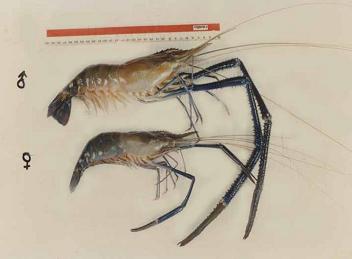|
Species
Biology
Macrobrachium rosenbergii is found in inland freshwater areas including
lakes, rivers, swamps, irrigation ditches, canals and ponds, as well as in estuarine
areas. This species requires brackishwater in the initial stages of their life cycle
(and therefore they are found in water that is directly or indirectly connected
with the sea). Mature male prawns are considerably larger than the females and the
second chelipeds are much larger and thicker. The head of the male is also proportionately
larger, and the abdomen is narrower. The head of the mature female and its second
walking legs are much smaller than the adult male. A ripe or ‘ovigerous' female
can easily be detected because the ovaries can be seen as large orange-coloured
masses occupying a large portion of the dorsal and lateral parts of the cephalothorax.
The life cycle of M. rosenbergii can be summarized as follows. The mating
(copulation) of adults results in the deposition of a gelatinous mass of semen on
the underside of the thoracic region of the female's body (between the walking legs).
Successful mating can only take place between ripe females, which have just completed
their pre-mating moult (usually at night) and are therefore soft-shelled, and hard-shelled
males. In tropical areas these coincide with the onset of the rainy season. Within
a few hours of copulation, eggs are extruded through the gonopores and guided by
the ovipositing setae (stiff hairs), which are at the base of the walking legs,
into the brood chamber. During this process the semen attached to the exterior of
the female's body fertilizes the eggs. The eggs are held in the brood chamber and
kept aerated by vigorous movements of the swimmerets. The length of time that the
eggs are carried by female freshwater prawns varies but is not normally longer than
three weeks. The number of eggs that are laid also depends on the size of the female.
Female prawns of M. rosenbergii are reported to lay from 80000 to 100000
eggs during one spawning when fully mature. Egg incubation time averaged 20 days
at 28°C (range 18-23 days).
Freshwater prawn eggs of this species are slightly elliptical, with a long axis
of 0.6-0.7 mm, and are bright orange in colour until 2-3 days before hatching when
they become grey-black. This colour change occurs as the embryos utilize their food
reserves. As the eggs hatch, rapid movements of the abdominal appendages of the
parent disperse the larvae. Freshwater prawn larvae are planktonic and swim actively
tail first, ventral side uppermost (i.e. upside down). M. rosenbergii larvae
require brackishwater for survival. The larvae go through 11 distinct stages before
metamorphosing into post larvae. Stage I larvae (zoeae) are just under 2 mm long
(from the tip of the rostrum to the tip of the telson). Larvae swim upside down
by using their thoracic appendages and are positively attracted to light. By stage
XI they are about 7.7 mm long. Newly metamorphosed post larvae (PL) are also about
7.7 mm long and are characterized by the fact that they move and swim in the same
way as adult prawns. They are generally translucent and have a light orange pink
head area.
On completion of their larval life, freshwater prawns metamorphose into post larvae
(PL). From this point onwards they resemble miniature adult prawns and become mainly
crawling rather than free-swimming animals. When they do swim it is usually in a
normal (dorsal side uppermost) way and in a forward direction. Rapid evasive movement
is also achieved by contracting the abdominal muscles and rapid movement of the
tail. Post larvae exhibit good tolerance to a wide range of salinities, which is
a characteristic of freshwater prawns.
Post larvae begin to migrate upstream into freshwater conditions within one or two
weeks after metamorphosis and are soon able to swim against rapidly flowing currents
and to crawl over the stones at the shallow edges of rivers and in rapids. In addition
to using the foods available to them as larvae, they now utilize larger pieces of
organic material, both of animal and vegetable origin. Post larval freshwater prawns
are omnivorous can also be cannibalistic.

Male and female Macrobrachium rosenbergii
(scampi)
Top
|